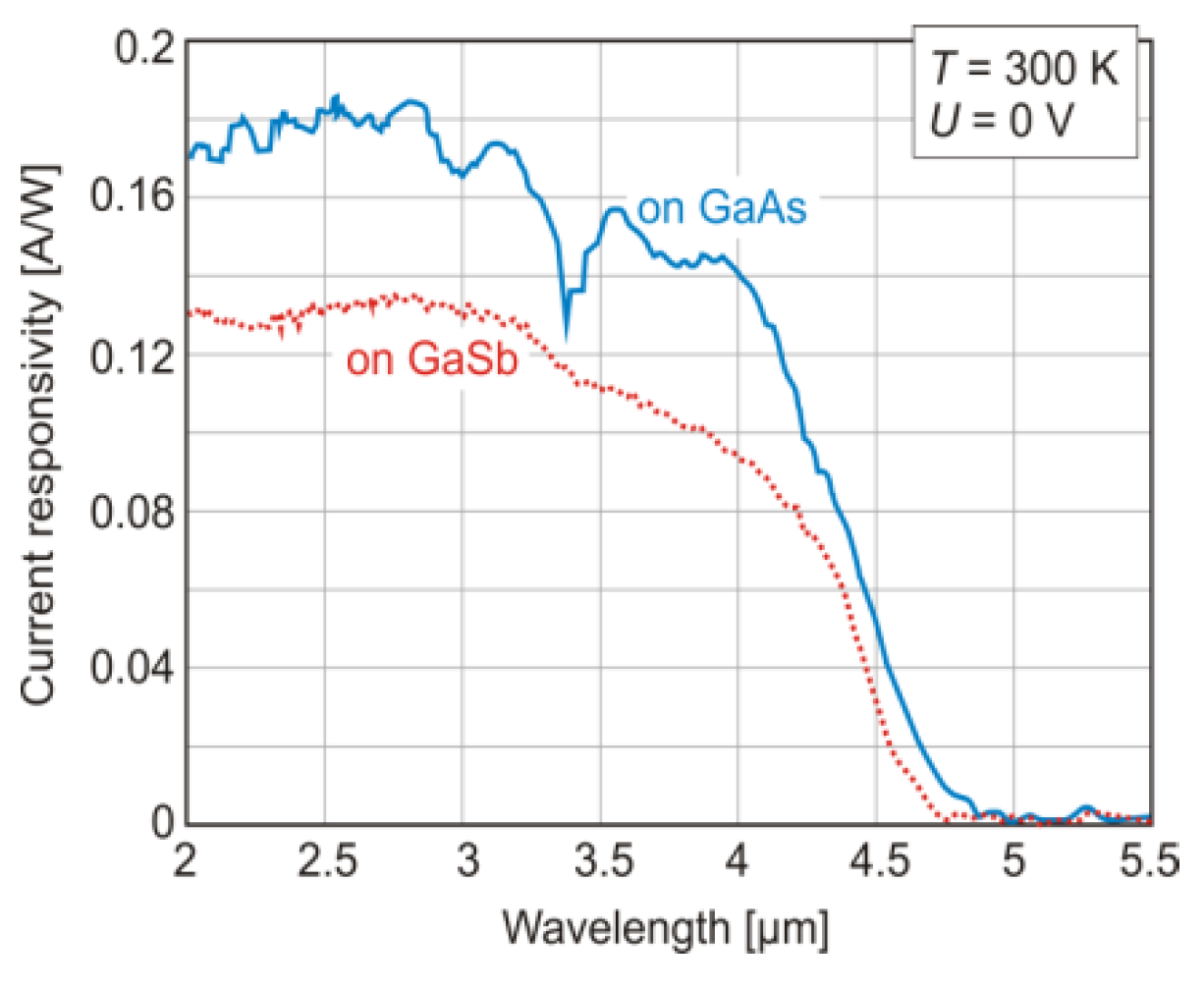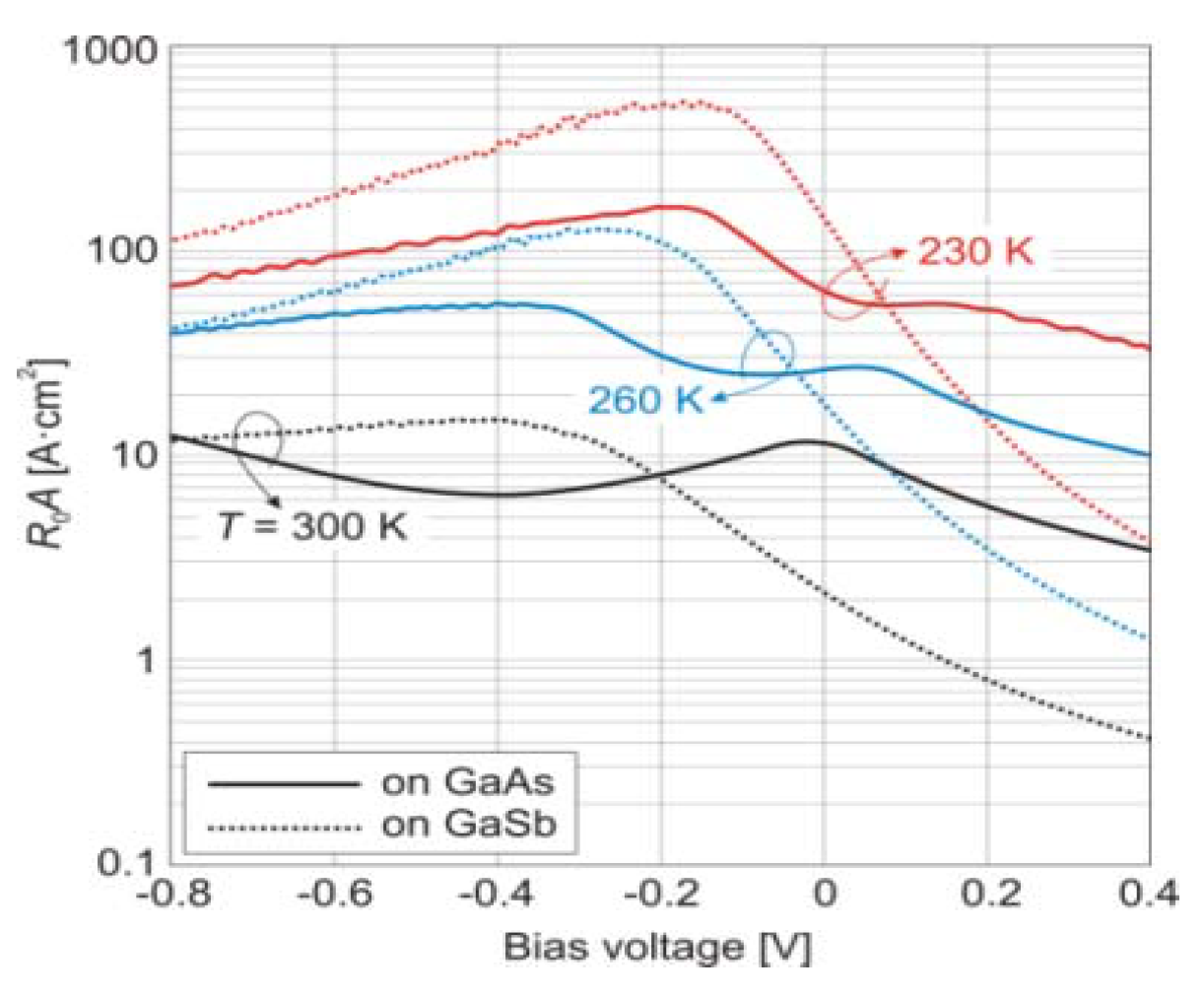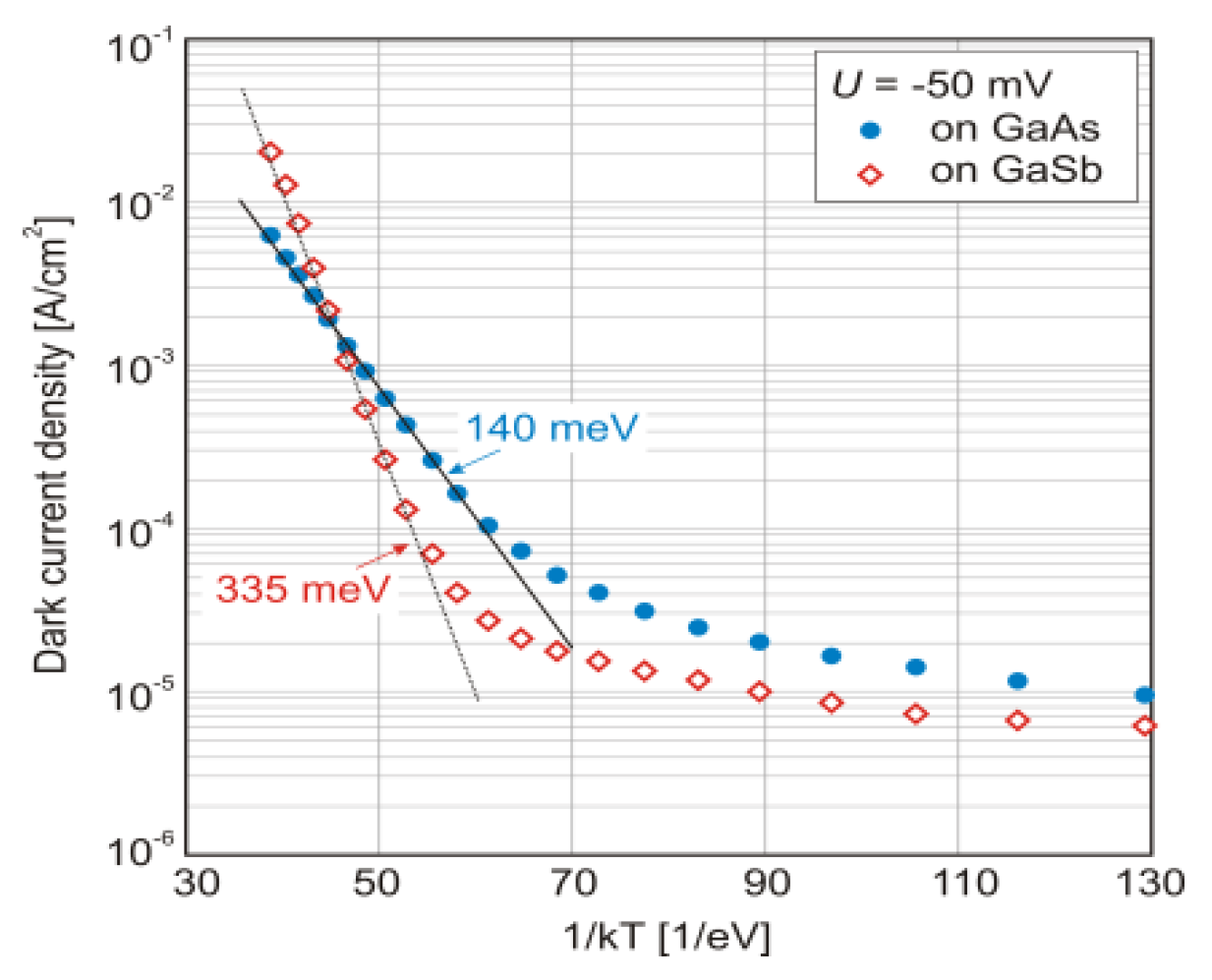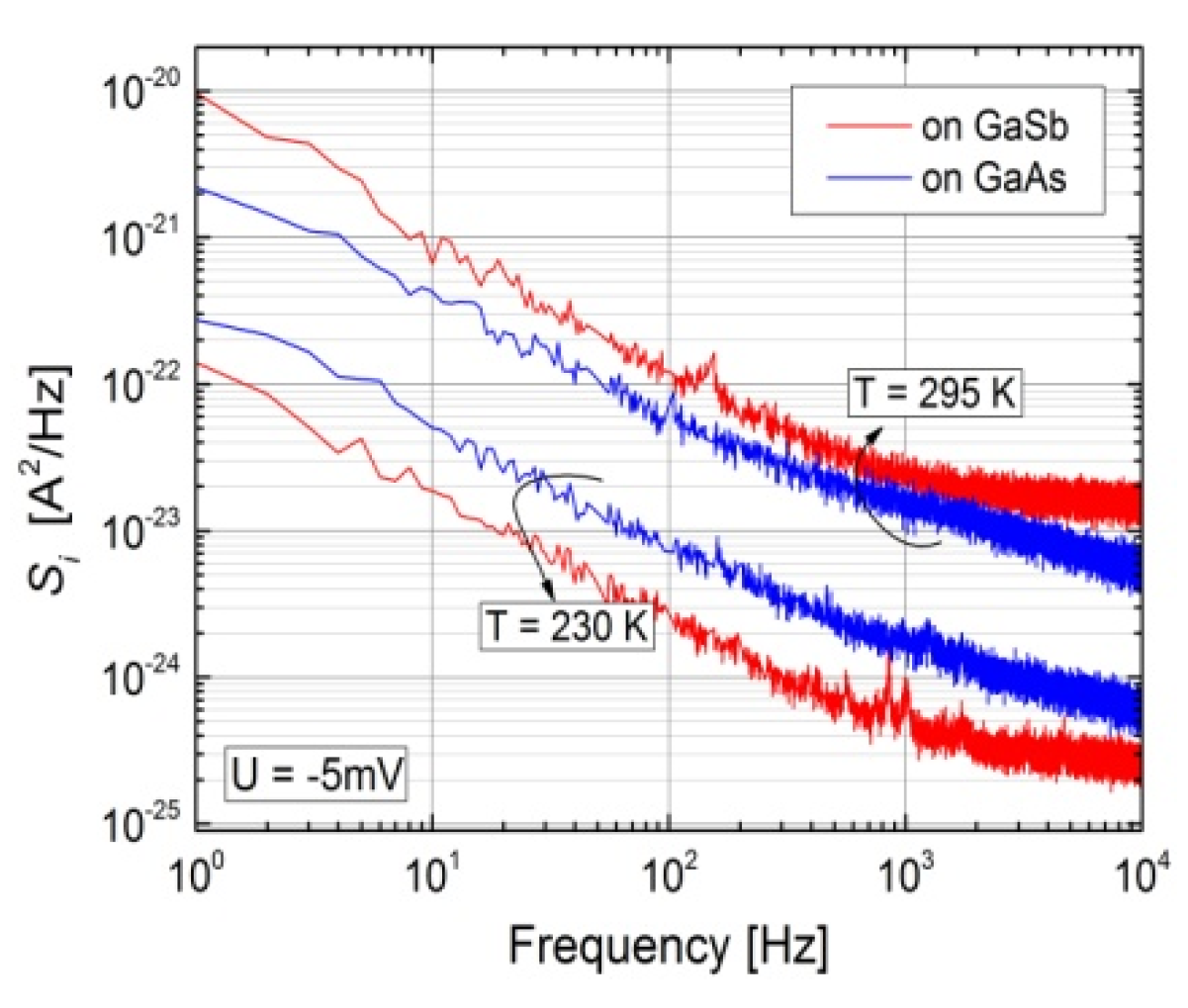InAs/GaSb Superlattice Based Mid-Infrared Interband Cascade Photodetectors Grown on Both Native GaSb and Lattice-Mismatched GaAs Substrates
Abstract
:1. Introduction
2. Devices Design
3. Results and Discussion
4. Conclusions
Acknowledgments
Conflicts of Interest
References
- Li, J.V.; Yang, R.Q.; Hill, C.J.; Chuang, S. L. Interband cascade detectors with room temperature photovoltaic operation. Appl. Phys. Lett. 2005, 86, 1–3. [Google Scholar] [CrossRef]
- Hackiewicz, K.; Martyniuk, P. Type-II InAs/GaSb (InAsSb) superlattices for interband cascade midwavelength detectors. Opt. Eng. 2018, 57, 1–5. [Google Scholar] [CrossRef]
- Steenbergen, E.H.; Nunna, K.; Ouyang, L.; Ullrich, B.; Huffaker, D.L.; Smith, D.J.; Zhang, Y.-H. Strain-balanced InAs/InAs1−xSbx type-II superlattices grown by molecular beam epitaxy on GaSb substrates. J. Vac. Sci. Technol. B 2012, 30, 02B107. [Google Scholar] [CrossRef]
- Plis, E.; Rodriguez, J.B.; Balakrishnan, G.; Sharma, Y.D.; Kim, H.S.; Rotter, T.; Krishna, S. Mid-infrared InAs/GaSb strained layer superlattice detectors with nBn design grown on a GaAs substrate. Semicond. Sci. Technol. 2010, 25, 1–4. [Google Scholar] [CrossRef]
- Gautam, N.; Myers, S.; Barve, A.V.; Klein, B.; Smith, E.P.; Rhiger, D.R.; Dawson, L.R; Krishna, S. High operating temperature interband cascade midwave infrared detector based on type-II InAs/GaSb strained layer superlattice. Appl. Phys. Lett. 2012, 10, 3–7. [Google Scholar] [CrossRef]
- Kaniewski, J.; Orman, Z.; Piotrowski, J.; Sioma, M.; Ornoch, L.; Romanis, M. Epitaxial InAs detectors optically immersed to GaAs microlenses. Proc. SPIE 2003, 4369, 721–729. [Google Scholar]
- Martyniuk, P.; Benyahia, D.; Kowalewski, A.; Kubiszyn, Ł.; Stępień, D.; Gawron, W.; Rogalski, A. Mid-wave T2SLs InAs/GaSb single pixel PIN detector with GaAs immersion lens for HOT condition. Solid-State Electron. 2016, 119, 1–4. [Google Scholar] [CrossRef]
- Soibel, A.; Keo, S.A.; Fisher, A.; Hill, C.J.; Luong, E.; Ting, D.Z.; Gunapala, S.D.; Lubyshev, D.; Qiu, Y.; Fastenau, J.M.; et al. High operating temperature nBn detector with monolithically integrated microlens. Appl. Phys. Lett. 2018, 112, 041105. [Google Scholar] [CrossRef]
- Adachi, S. Optical dispersion relations for GaP, GaAs, GaSb, InP, InAs, InSb, AlxGa1-xAs, and In1-xGaxAsyP1-y. J. Appl. Phys. 1989, 66, 6030–6040. [Google Scholar] [CrossRef]




| Detector Type | Ri (0 V) [AW−1] | R0A [Ωcm2] | D* [cmHz1/2W−1] Non-Immersed | D* [cmHz1/2W−1] Optically Immersed |
|---|---|---|---|---|
| T2SLs IC on GaAs | 0.14 | 10 | 3.5 × 109 | 3.7 × 1010 |
| T2SLs IC on GaSb | 0.09 | 2 | 1 × 109 | 3.7 × 109 |
© 2019 by the authors. Licensee MDPI, Basel, Switzerland. This article is an open access article distributed under the terms and conditions of the Creative Commons Attribution (CC BY) license (http://creativecommons.org/licenses/by/4.0/).
Share and Cite
Hackiewicz, K.; Kopytko, M.; Rutkowski, J.; Martyniuk, P.; Ciura, Ł. InAs/GaSb Superlattice Based Mid-Infrared Interband Cascade Photodetectors Grown on Both Native GaSb and Lattice-Mismatched GaAs Substrates. Proceedings 2019, 27, 38. https://doi.org/10.3390/proceedings2019027038
Hackiewicz K, Kopytko M, Rutkowski J, Martyniuk P, Ciura Ł. InAs/GaSb Superlattice Based Mid-Infrared Interband Cascade Photodetectors Grown on Both Native GaSb and Lattice-Mismatched GaAs Substrates. Proceedings. 2019; 27(1):38. https://doi.org/10.3390/proceedings2019027038
Chicago/Turabian StyleHackiewicz, Klaudia, Małgorzata Kopytko, Jarosław Rutkowski, Piotr Martyniuk, and Łukasz Ciura. 2019. "InAs/GaSb Superlattice Based Mid-Infrared Interband Cascade Photodetectors Grown on Both Native GaSb and Lattice-Mismatched GaAs Substrates" Proceedings 27, no. 1: 38. https://doi.org/10.3390/proceedings2019027038
APA StyleHackiewicz, K., Kopytko, M., Rutkowski, J., Martyniuk, P., & Ciura, Ł. (2019). InAs/GaSb Superlattice Based Mid-Infrared Interband Cascade Photodetectors Grown on Both Native GaSb and Lattice-Mismatched GaAs Substrates. Proceedings, 27(1), 38. https://doi.org/10.3390/proceedings2019027038




